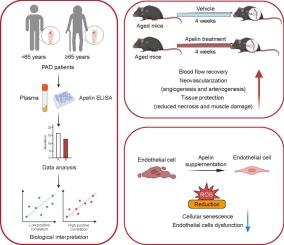内皮素对外周动脉疾病中年龄相关性新生血管损伤的影响
IF 5.1
2区 医学
Q1 MEDICINE, RESEARCH & EXPERIMENTAL
引用次数: 0
摘要
摘要外周动脉疾病(PAD)是老年人常见的血管疾病。衰老导致内皮细胞(ECs)衰老和功能障碍,从而导致新生血管受损。本研究旨在探讨尖蛋白在老年PAD患者中恢复新生血管的治疗潜力。材料和方法我们测量了年轻和老年PAD患者以及后肢缺血(HLI)小鼠的血浆apelin水平。老龄小鼠分别用apelin或载药治疗。采用激光多普勒成像监测血流恢复情况。为了评估新生血管,我们进行了基于显微ct的血管造影、全载和免疫荧光染色。此外,通过测定活性氧、衰老相关β-半乳糖苷酶染色和一系列功能分析来评估apelin对ECs的影响。在这里,我们首次报道老年PAD患者血浆apelin水平显著降低,并与相关临床参数密切相关。在HLI后小鼠中也观察到类似的减少。在老年HLI小鼠中,apelin治疗显著促进血流恢复。进一步分析表明,apelin促进缺血后的新生血管形成。体内和体外实验均证实,apelin通过激活APJ,改善内皮功能,减缓ECs衰老,从而促进新生血管的形成。本研究将临床观察与实验证据相结合,突出了apelin在促进新生血管形成方面的治疗潜力,并增强了其在老年PAD治疗中的翻译相关性。本文章由计算机程序翻译,如有差异,请以英文原文为准。

Effects of apelin on age-associated neovascularization impairment in peripheral artery disease
Aims
Peripheral artery disease (PAD) is a prevalent vascular condition in the elderly. Aging induces senescence and dysfunction of endothelial cells (ECs), which contributes to impaired neovascularization. This study aims to investigate the therapeutic potential of apelin in restoring neovascularization in older patients with PAD.
Materials and methods
We measured plasma apelin levels of young and elderly patients with PAD, as well as in mice following hindlimb ischemia (HLI). Aged mice were treated with apelin or vehicle. Blood flow recovery was monitored using Laser Doppler imaging. To evaluate neovascularization, we performed micro-CT-based vascular angiography, whole-mount, and immunofluorescence staining. In addition, the effects of apelin on ECs were assessed by measuring reactive oxygen species, senescence-associated β-galactosidase staining, and performing a series of functional assays.
Key findings
Here, we report for the first time that plasma apelin levels are significantly reduced in older PAD patients and are closely associated with relevant clinical parameters. A similar reduction was also observed in mice following HLI. In aged mice with HLI, apelin treatment markedly enhanced blood flow recovery. Further analysis demonstrated that apelin promotes neovascularization after ischemia. Both in vivo and in vitro experiments confirmed that apelin facilitates neovascularization by improving endothelial function and mitigating ECs senescence via activation of APJ.
Significance
This study integrates clinical observations with experimental evidence, highlighting the therapeutic potential of apelin in promoting neovascularization and enhancing its translational relevance for the treatment of PAD in the elderly.
求助全文
通过发布文献求助,成功后即可免费获取论文全文。
去求助
来源期刊

Life sciences
医学-药学
CiteScore
12.20
自引率
1.60%
发文量
841
审稿时长
6 months
期刊介绍:
Life Sciences is an international journal publishing articles that emphasize the molecular, cellular, and functional basis of therapy. The journal emphasizes the understanding of mechanism that is relevant to all aspects of human disease and translation to patients. All articles are rigorously reviewed.
The Journal favors publication of full-length papers where modern scientific technologies are used to explain molecular, cellular and physiological mechanisms. Articles that merely report observations are rarely accepted. Recommendations from the Declaration of Helsinki or NIH guidelines for care and use of laboratory animals must be adhered to. Articles should be written at a level accessible to readers who are non-specialists in the topic of the article themselves, but who are interested in the research. The Journal welcomes reviews on topics of wide interest to investigators in the life sciences. We particularly encourage submission of brief, focused reviews containing high-quality artwork and require the use of mechanistic summary diagrams.
 求助内容:
求助内容: 应助结果提醒方式:
应助结果提醒方式:


